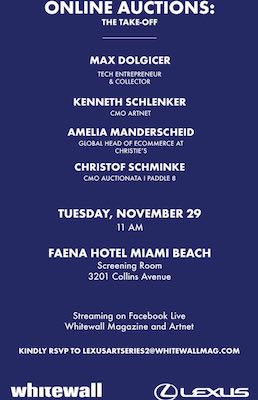Art Basel Miami Beach 2016 was my fifth year visiting the art fair and its many satellite fairs, events, talks and parties. I went to ABMB, the main drag, Artsy partners Design Miami, Pulse, Untitled, Art Miami, satellite fairs Scope, X Contemporary and NADA. I most enjoyed a private tour of Julio Le Parc’s exhibition at The Perez Art Museum Miami organized by Sotheby’s, their young collectors’ cocktails and the tiny, but so dear to my own artistic medium, IFPDA INK Art Fair. I saw Elew play rock jazz and crashed some billionaire collector’s dinner to which B-listers like me are never invited. I almost lost hearing at the Kendrick Lamar concert. Finally, Artsy teamed up with SoundCloud and Gucci to produce an inspiring event in the Faena Art Dome with Rachel Rossin performing live VR to the voice of Abra.
While the above is a decent list for a week of “work”, I used my time in Miami to network with people that work in technology and art and to check-in on the lingering question: Has the Art World come officially online yet? Remarkably, for the first time this year, everyone answered with a definite “yes”.
I attended three panels - Debating Disruption: Has Technology Really Changed the Art World? at Art Basel Conversations, Online Auctions: The Take-Off and The Evolution of Artist Management at Faena organized by Whitewall. I strongly encourage you to watch the first one, where Artsy COO Sebastian Cwilich dives deep into what we’ve been working on at Artsy and emphasizes our approach of partnering with the existing art world.
Artsy did not participate in the online auctions panel, but our presence was strongly felt with the moderator, Max Dolgicer, mentioning it multiple times. He notably stated that the barrier for going online was not technology, but brand. While I agree with that general sentiment, I believe many players underestimate the technology aspect and don’t understand it. Excellent user experience and flawless execution are only table stakes. Artsy’s success online is equally fueled by a long term vision, strong mission, good business sense and a beautiful design sitting atop of a well thought and powerful technology platform built by an A team of engineers. Creating an environment where this is even possible requires a new kind of executive management that understands, breathes and lives technology. Only then, making this actually happen day-to-day can be someone’s job and is hard.
A lot of talk was about barriers (e.g. buyer protection), but very little about innovation. Artnet wants to build new tools atop of pricing data and making it easy to buy art at the “right” price. Christie’s (Collectrium) is focusing on smarter client tools and better information management. Naturally these speak to those companies’ strongest products, but what about the big picture? Now that the art world has come online, what would we like it to be? I see the future where there are many more more galleries, not fewer (e.g. China has 100 cities, many brand new, with population exceeding 1MM people compared to only 10 in the U.S.). One with a lot more local attention and international opportunity enabled by the Internet. More small art fairs like INK and fewer lavish parties with people who don’t care about art. I imagine new digital interfaces, ranging from augmented and virtual reality to voice (ask your Amazon Echo (Alexa) to “enable Artsy” today). I see growth on the very top of the market and a lot more density in the lower tiers, where people interested in art become first time buyers more frequently.
That latter sentiment was echoed by Magnus Resch at the artist management panel. I very much dislike his disruptive message, I disagree when he calls artists to deliver artworks directly to auctions (ironically offering to do it himself for Hank Willis Thomas sitting next to him) and I disagree when he says MCH is the company reaping the biggest profits from art fairs and disagree when he calls for artists to organize their own art fairs. Yet, he highlighted one very important challenge during this panel - the filling of the gap between those interested in art and those buying art.
Finally, I really enjoyed hearing Hank Willis Thomas saying that the art market has already been disrupted by entire new audiences, new collectors becoming patrons again, using technology and at the same time having intimacy and personal relationships, inspiring one another and not focusing on the “transactional” aspects of the art world. I loved hearing him being just so happy that someone, anyone, wants to live with his work. And I appreciated Marion Maneker’s emphasis on how art is currently ascending in the Maslow hierarchy of needs.
See you next year in Miami!



